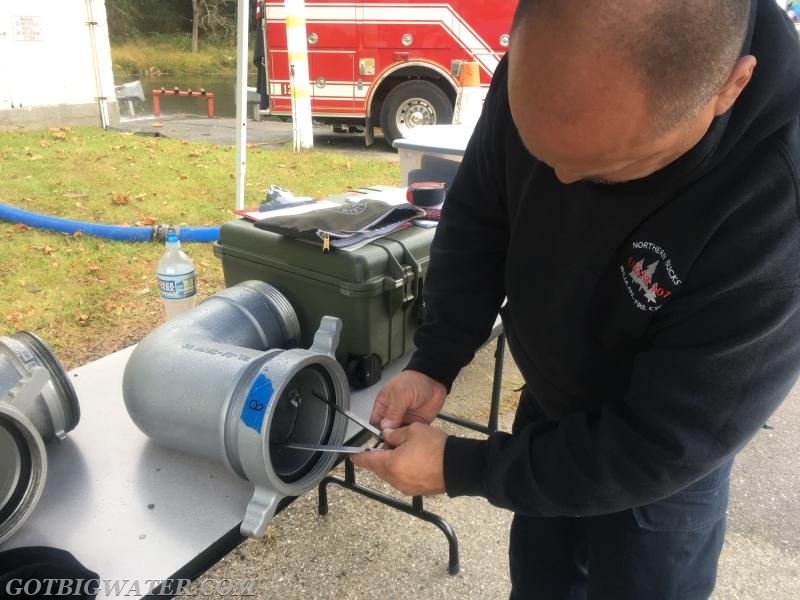| On September 30, 2017, the folks from GBW Associates, LLC and Water Supply Innovations, LLC conducted a number of flow tests on 30 different makes, models, and styles of 6-inch, fire department suction strainers. The summary results from those flow tests are presented in this document.
All testing was done at the Hunterdon County Emergency Services Training Center in Annandale, New Jersey. Engine 1262 from the Glen Gardner Fire Company was used for each flow test. The pumper was equipped with a Hale QMax 2,250 gpm single-stage pump powered by a 515 hp diesel motor.
The Test Conditions were as follows:
• 20-feet of 6-inch Kochek lightweight suction hose;
• 3.52-feet of lift;
• 371-feet test site elevation;
• Air temperature between 60 degrees F and 69 degrees F;
• Water temperature between 60 degrees F and 70 degrees F;
• 50-feet of 4-inch hose from the pump’s high-flow discharge supplying a 2-1/2-inch Hose Monster; and,
• Dual, 3-inch hoses, each 50-feet in length, each connected to a 2-1/2-inch discharge, and each supplying a portable monitor outfitted with an Akron Flow Test Kit and 1-3/4-inch smooth bore tip.
• All strainers tested, except the floating strainers and the ice strainer, were tested at a depth of 25-inches below the water’s surface.
• The same person operated the fire pump.
• The same person oversaw pump operations and suction strainer deployment.
• The same person collected all physical data on each suction strainer.
• The same person recorded all gauge readings.
The only variable in the entire flow testing process was the suction strainer being tested.
There were a few choices in deciding upon the test conditions...the motor speed could have been held as the constant, the net pump pressure could have been held as the constant, the vacuum reading could have been held as the constant...those were three viable choices. We (GBW Associates, LLC and Water Supply Innovations, LLC) chose to "run the throttle up until no flow increase occurred" choice. While keeping lift, suction hose length, discharge valve position, and suction strainer depth constant - run the throttle up until no further flow increase occurs. We feel that the "run the throttle up" constant represents the common scenario in drafting...a pump operator sets up to draft, gets a prime, and then runs the throttle up and flows water. If more water is needed, the first thing done is run the throttle up...thus the basis of our set-up.
Prior to the first suction strainer flow test, a flow test was completed using no strainer on the suction hose. This test provided a baseline for comparison of all strainers: as strainers were added to the end of the suction hose, a restriction in flow was expected. For each flow test, data was recorded at peak output flow, which in most cases was also the point at which pump cavitation began.
General Notes About the Flow Tests
• The baseline flow test measured maximum flow without the use of a suction strainer.
• All flow readings were obtained using remote test gauges connected to a 2-1/2” HoseMonster flow diffuser and to an Akron Flow Test Kit on a portable deluge gun outfitted with a 1-3/4-inch smooth bore nozzle.
• Motor speed readings were obtained using the digital tachometer on the pumper’s pump panel.
• Vacuum readings were obtained using a remote test gauge connected to the pump’s vacuum test port.
• All test gauges were either new or recently calibrated. All test gauges were also field verified the morning of the flow tests. Therefore, all flow readings are expected to have a 5% or less margin of error.
An interesting thing happened in that we had a few flows on suction strainers measure greater than the flow when no suction strainer was used. First, those higher flows were within our 5% margin of error. Second, the "no suction" strainer flow test was the first of 30 some plus tests that day. We suspect that pump performance increased a bit after the pumper's motor warmed up and the big body pump was able to increase its output some.
We really appreciate all of the folks who helped pull off this 8-hr day of flow testing...many contributed equipment, funds, and of course manpower and knowledge!
A more in depth written report is forthcoming explaining in detail more about the test set-up and strainer physical data.
Contact Mark E. Davis, President of GBW Associates, LLC with any questions. (thebigcamel@gotbigwater.com). |








